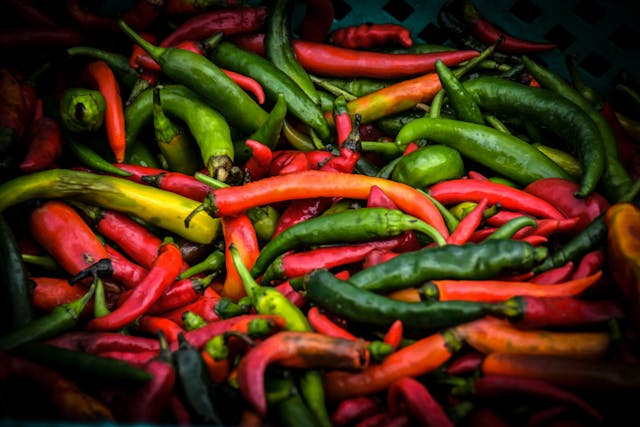Let’s dive into why we should eat more peppers. Explore the advantages of peppers, including health benefits and nutrition.
Table of Content:
Why Eat Peppers?
Peppers, whether sweet or spicy, are a staple in cuisines around the world, beloved for their versatility, vibrant colors, and flavorful punch. But beyond their culinary appeal, peppers are a nutritional powerhouse packed with vitamins, minerals, antioxidants, and compounds that offer numerous health benefits. From boosting immunity to promoting heart health and weight management, these colorful vegetables can be an essential part of a healthy diet. This article explores the nutritional profile of peppers and the wide range of health benefits they offer. So, why we should eat more peppers?
Nutritional Content of Peppers
Peppers come in many varieties, each offering a slightly different nutrient composition, but they generally share a common set of key nutrients. For example, bell peppers, which are mild and sweet, are incredibly rich in vitamin C, especially the red varieties. On the other hand, hot peppers like jalapeños and habaneros bring capsaicin, a compound responsible for their heat, which also provides several health benefits.
Key Nutrients in Peppers (Per 100g Raw)
- Calories: 20-40 kcal
- Carbohydrates: 4-9 g
- Fiber: 1-2 g
- Protein: ~1 g
- Fat: ~0 g
- Vitamins:
- Vitamin C: Extremely high, particularly in red bell peppers (up to three times the vitamin C content of an orange)
- Vitamin A (Beta-Carotene): High, especially in red and yellow peppers
- Vitamin B6: Important for brain function and energy metabolism
- Folate: Essential for cell function and tissue growth
- Minerals:
- Potassium: Helps regulate blood pressure
- Magnesium: Supports muscle and nerve function
- Antioxidants: Rich in carotenoids like lutein and zeaxanthin
The nutritional profile of peppers is a strong foundation for their wide-ranging health benefits. More information regarding vitamins and minerals.

Health Benefits of Peppers
1. Rich in Antioxidants
Peppers, especially the brightly colored varieties like red, yellow, and orange, are loaded with antioxidants that play a crucial role in fighting oxidative stress. Oxidative stress is an imbalance of free radicals and antioxidants in the body, leading to cell damage, inflammation, and a higher risk of chronic diseases like cancer and heart disease.
The antioxidants in peppers include:
- Vitamin C: This potent antioxidant protects cells from damage and helps in the regeneration of other antioxidants in the body. It also plays a critical role in immune function and skin health by promoting collagen production.
- Carotenoids: The vibrant colors of peppers are a direct result of carotenoids like beta-carotene, lutein, and zeaxanthin. These compounds are particularly important for eye health and may lower the risk of developing conditions like cataracts and age-related macular degeneration.
- Capsaicin: Found primarily in hot peppers, capsaicin has potent anti-inflammatory properties and may help reduce the risk of cancer by inhibiting the growth of cancerous cells.
2. Immune System Boost
Peppers, especially bell peppers, are a fantastic source of vitamin C, an essential nutrient for immune system function. One medium-sized red bell pepper provides more than 150% of the recommended daily intake of vitamin C. This vitamin is crucial for the production of white blood cells, which are responsible for defending the body against infections.
In addition to vitamin C, peppers contain vitamin A, which also supports the immune system. Vitamin A helps maintain the health of skin and mucous membranes, the body’s first line of defense against pathogens.
3. Eye Health Protection
Peppers, particularly red and orange varieties, are rich in two specific carotenoids—lutein and zeaxanthin—which are known to support eye health. These antioxidants help filter harmful blue light and protect the delicate tissues of the eyes from oxidative damage.
Lutein and zeaxanthin are especially beneficial in reducing the risk of cataracts and age-related macular degeneration, two common causes of vision loss. Including peppers in your diet regularly can be a simple way to support long-term eye health.
4. Heart Health Benefits
Peppers contribute to heart health in several ways:
- Potassium: This mineral helps regulate blood pressure by balancing sodium levels in the body. A diet rich in potassium, like that provided by peppers, can help reduce hypertension and the risk of heart disease.
- Fiber: Peppers are also a good source of dietary fiber, which can help lower cholesterol levels and improve overall heart health. Fiber promotes healthy digestion and can prevent constipation, contributing to a balanced and heart-healthy diet.
- Capsaicin: In addition to its antioxidant properties, capsaicin is known to improve blood circulation and has been shown in some studies to lower cholesterol levels. It may also promote weight loss by increasing metabolism, which can help reduce the risk of heart disease.
5. Weight Management and Metabolism
Peppers are low in calories but high in fiber, making them an excellent choice for weight management. They add volume and color to meals without contributing a significant amount of calories, making you feel fuller for longer.
Hot peppers, in particular, may offer an additional benefit for those looking to lose weight. Capsaicin, the compound responsible for the heat in spicy peppers, has been shown to increase metabolism by promoting thermogenesis—the process by which the body burns calories to produce heat. Capsaicin may also help reduce appetite, making it easier to manage calorie intake.
6. Anti-inflammatory Properties
Capsaicin has potent anti-inflammatory effects, which can benefit individuals with conditions like arthritis or inflammatory bowel diseases. It works by inhibiting certain pathways in the body that lead to inflammation, providing relief for chronic inflammatory conditions.
In addition to capsaicin, the antioxidants in peppers contribute to reducing inflammation throughout the body, lowering the risk of chronic diseases such as diabetes, heart disease, and certain types of cancer.
7. Digestive Health
Peppers, particularly the sweet varieties, are a good source of dietary fiber. Fiber is essential for maintaining a healthy digestive system, as it promotes regular bowel movements and prevents constipation. It also supports gut health by feeding beneficial bacteria in the digestive tract, which play a crucial role in overall health.
For those who enjoy spicy foods, capsaicin can also stimulate digestion by increasing gastric secretions, though it should be consumed in moderation to avoid irritation in people with sensitive stomachs.
8. Skin Health
The high vitamin C content in peppers is essential for skin health. Vitamin C promotes the production of collagen, the protein responsible for keeping skin firm, smooth, and youthful. Moreover, the antioxidants in peppers protect the skin from damage caused by UV rays and pollution, reducing signs of aging.
Beta-carotene, which is abundant in red and yellow peppers, also plays a role in protecting the skin from sun damage and aiding in the repair of damaged skin cells.
Variations of Peppers
Peppers are an incredibly versatile ingredient in cooking, used in a variety of dishes across different cuisines. They come in different types, flavors, and heat levels. Let’s see our quick guide on some popular types of peppers and how they’re used in food.

1. Bell Peppers (Sweet Peppers)
- Taste: Sweet and mild.
- Colors: Green, red, yellow, and orange.
- Uses:
- Salads
- Stir-fries
- Stuffed peppers (filled with rice, meat, or vegetables)
- Fajitas
- Roasted or grilled as a side dish
2. Jalapeño Peppers
- Taste: Mild to medium heat, with a slight sweetness.
- Uses:
- Salsas
- Pickled for nachos or sandwiches
- Poppers (stuffed and deep-fried)
- Toppings for tacos or pizza
- In guacamole for a spicy kick
3. Serrano Peppers
- Taste: Hotter than jalapeños with a bright, crisp flavor.
- Uses:
- Spicy salsas
- Diced for fresh salads
- Pickled or grilled
- Mexican dishes like ceviche or pico de gallo
4. Habanero Peppers
- Taste: Very hot with a fruity undertone.
- Uses:
- Hot sauces
- Marinades for chicken or seafood
- Spicy soups or stews
- Caribbean dishes like jerk chicken
5. Poblano Peppers
- Taste: Mild heat, rich, and slightly smoky.
- Uses:
- Roasted or stuffed (chiles rellenos)
- Sautéed in fajitas or casseroles
- In mole sauce (a rich Mexican sauce)
6. Chipotle Peppers
- Taste: Smoky and medium-hot (dried and smoked jalapeños).
- Uses:
- Chip


